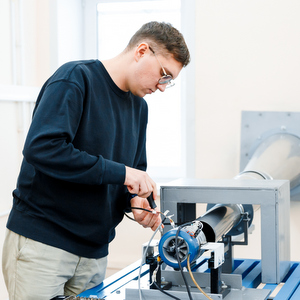“We have begun comprehensive tests of the first prototype of the small SGTE-22 “Kolibri” gas turbine engine developed at our University and designed for small, but high-speed and load-lifting jet unmanned aerial vehicles. The engine has been manufactured, fully assembled and equipped with the experimental prototype of the control system developed at the University”, said Ivan Zubrilin, Director of the Engineering Centre of Samara University, Head of the Youth Research Laboratory “Power Facilities”. “During the tests that have begun, the estimated specifications of the engine for various operating modes must be experimentally confirmed. The tests will last about three months”.
According to Ivan Zubrilin, the main key feature of the small gas turbine engine “Kolibri”, compared, for example, to piston engines of the same dimension is a high thrust-to-weight ratio. That is, it is small, but it is bold — almost like an ant, which can lift a load much more than its weight. The small engine weighs only 2.1 kg, while its maximum thrust should be 220 N (Newtons). The “Kolibri” length is 30.6 cm, its diameter is 11.8 cm. According to calculations, a small drone equipped with the engine with its estimated total take-off weight of 45 kg will be able to reach maximum speed of 800 km per hour with maximum flight altitude of 9 km.
Other features of the development include the integrated (not separate) control system, the electric engine start, and the option of its remote restart during flight. The engine can be equipped with an electric generator, which will be used to recharge the battery that powers the UAV electronic equipment.
“The drone equipped with such an engine will differ not only in high speed, but also in increased payload capacity. Therefore, the “Kolibri” can potentially be used to produce cargo drones. Such devices may be in demand in remote regions of the country, and if necessary, they will be able to solve the logistical task of delivering cargo to hard-to-reach areas in absence of land-transport infrastructure”, said Anton Poltoradnev, Manager of the “Kolibri” project, specialist of the Engineering Centre.
Another advantage is that the “Kolibri” will operate using traditional aviation fuel — kerosene. If we compare kerosene with conventional lithium-polymer batteries used in drones, then with the same volumes occupied, the energy consumption of kerosene turns out to be 40 times greater than that of batteries. Meanwhile, it takes only a few minutes to refuel the UAV with kerosene. The batteries take much longer to charge. If we compare the “Kolibri” with gasoline engines for drones, then kerosene has a better calorific value than gasoline, and with the same mass of fuel gives more thrust.
According to Ivan Zubrilin, the “Kolibri” is the very first and smallest in the line of small gas turbine engines being developed at the University’s Youth Laboratory. In addition to the SGTE-22 already being tested, the laboratory is working on projects for two more engines — SGTE-40 “Chaika” (Seagull) and SGTE-100 “Orel” (Eagle). In accordance with their bird’s name and digital designation, these engines will surpass the “Kolibri” in size, thrust, power and a number of other specifications. So, the “Chaika” mass will be 4 kg, thrust — 400 N, body length — 38 cm, diameter — 15 cm. The “Orel” mass is 13 kg, thrust — 1,200 N, length — 62 cm, diameter — 24 cm.
More engines that are powerful will make it possible to implement new promising projects. For example, based on four “Orels”, it is planned to create a high-speed cargo drone with the capacity to take off and land vertically in any weather and in any terrain. The development will be able to deliver cargo weighing up to 110 kg to a given point with a maximum flight speed of 480 km per hour.
For testing the entire line of these developments, the test bench was designed, which allows exploring both individual components of small gas turbine engines — compressor, combustion chamber, turbine, lubrication system, inlet device and nozzle — and the engine as a whole. The test bench is equipped with the fuel system, a set of various sensors for measuring temperature and flow of air and fuel, as well as the automated measurement results processing system. The equipment makes it possible to study the working processes in SGTE with a thrust of up to 1,500 N.
“Among the developments created for this test bench, there are the high-precision thrust measuring device operating in a wide range of measured values, the fuel supply system that allows using both traditional and promising fuels, as well as the ASTRA conceptual design system adapted for testing, which creates a digital twin of the product and train it online based on test results”, said Ivan Zubrilin.
 RU
RU  EN
EN  CN
CN  ES
ES 